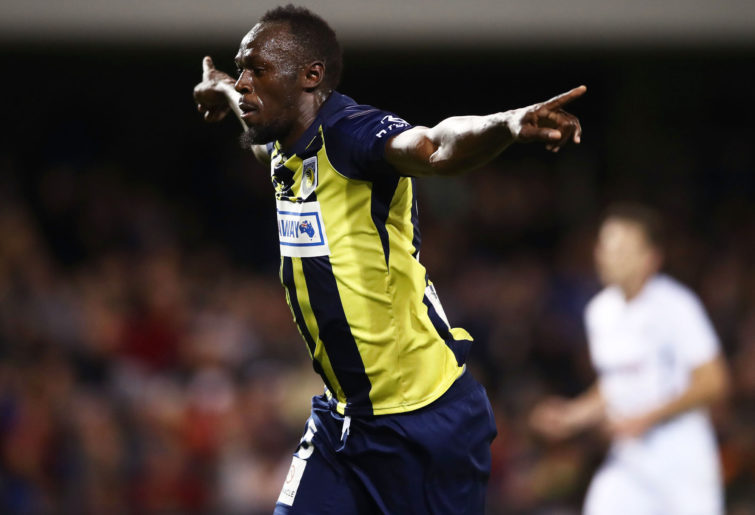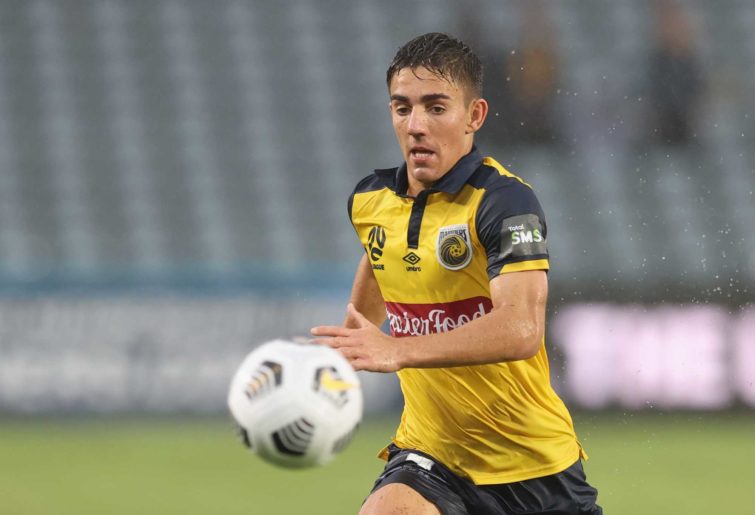On a spring Friday evening in Gosford in 2018, more than 10,000 fans flocked to Central Coast Stadium to watch a pre-season game.
This was substantially more spectators than had gone to watch most of the local side’s faltering A-League fortunes the previous season. Early in the second half, two players made their entrances to the game, both of whom would end up defining the club the Central Coast Mariners were, and the one they became.
One of course, was Usain Bolt. He would go on to reject a contract with the club. The other was Josh Nisbet. He would go on to play a huge role in the Mariners resurgence which culminated in a stunning 6-1 grand final victory last Saturday.
When Bolt and Nisbet stood side-by-side waiting to go on in that 2018 pre-season game, their 36 centimetre height difference made many wonder whether the Mariners were giving a ball boy the chance to play alongside one of the most recognisable athletes on the planet.
Nearly five years later, Nisbet’s stature in the game is such that his height is simply not a factor. His 2018 appearance represents a moment, in hindsight, where the Mariners began to rescue themselves, even while the club was being lambasted for allowing the Bolt circus to further tarnish its reputation as one that had punched substantially above its weight in the early iterations of the A-League.
Then though, it was beginning to be regarded as a basket case as losses and low league ranking began to pile up season after season. Nisbet had come through the Mariners Academy, and his ascension to the first team showed the club the way out of its horrible form and overall slide.

Usain Bolt celebrates scoring a goal for the Mariners. (Photo by Matt King/Getty Images)
Last Saturday night in Parramatta, the Central Coast Mariners put huge distance between their late-last-decade alter ego and the club they have become.
On the pitch, a performance as thrilling and captivating as any seen in A-League history was rewarded with their second A-League title but one which will live long in the annals of Australian sporting folklore. It was a team that simply bedazzled their more vaunted opponents.
From the towering defensive muscle and calmness of Vanautu’s Brian Kaltak, to Nisbet’s incessant work-rate, to the blinding pace of Sammy Silvera, to the poise and grace of Marco Tulio, to the finishing instincts of the A-League’s greatest showman Jason Cummings. And all points in between.
Off the pitch, the fingerprints of head coach Nick Montgomery were all over the club and team. He trained many of the current first team squad as they were taking their professional baby steps at the Mariners Centre of Excellence. He is a no-nonsense Yorkshiremen whose coastal heart beats blue and yellow, and who has re-instilled in the club the values it was founded on.
He has made his own journey from player to youth coach to the top job. He has done so with a squad made up of overseas players most people hadn’t heard of, who were seemingly on their last professional chance.
Added to that are the young players, some deemed surplus to needs at NPL level, but who caught the eye of “Monty” and the Mariners coaching staff and were given their shot. This squad, built by the necessities of a shoestring budget, is the youngest in the A-League.
It contains the likes of Max Ballard, Harry Steele and Jacob Farrell, players whose raw talent was recognised and nurtured by Montgomery and assistant Sergio Raimundo, to play vital roles in the club’s championship triumph. Who could forget the personal duels between Farrell and Adelaide United prodigy Nestory Irankunda in the finals series? Pure theatre.
Speaking of theatre, Saturday’s grand final could not have been scripted better by a group of striking Hollywood screenwriters.
The backdrop to the game was the APL’s decision to award the hosting rights to Sydney, a plot twist which meant more than 20,000 “Coasties” travelled to Western Sydney to see their team triumph, rather than flying to Melbourne to hope for the same outcome.
This seemed the only “advantage” as the smallest team in the league took on the biggest – at least in terms of resources. CommBank Stadium resembled a giant night club at times, with light shows, fireworks and flamethrowers adding to the noise of the blue and yellow army, who substantially outnumbered their sky-blue adversaries.
It was a rollicking atmosphere of noise, colour and entertainment, and the game more than lived up to the special effects. There was no cagey shadow-boxing or sitting back and waiting for an opening. Both sides attacked from the outset, an end-to-end opera of speed, precision and movement.
This was a great game, a showcase of all that is right with Australian football, set against the backdrop of what might be administratively wrong with it.

(Photo by Ashley Feder/Getty Images)
In the middle of the tumult stood Cummings, a striker with a Vaudevillian swagger, a sense of theatre and character inspired by his love of, and momentary participation in professional wrestling.
That he scored a hat-trick in his last game for the club to break the record of former player and now-commentator Daniel McBreen gives an insight into the former Scotsman and now fully fledged Aussie’s sense of occasion. He will be a loss not just to the Mariners but the entire league.
In an era where sportspeople portray decidedly beige personalities for fear of giving opponents any ammunition, Cummings turned his persona up to eleven. He backed himself and delivered on field and off.
Rarely does a redemptive sporting story have this kind of conclusion. Had the Mariners lost to Melbourne City, it would still have been a memorable tale of defying expectation to climb the mountain towards success, only to fall heroically short at the final hurdle.
That’s probably how the scriptwriters would have crafted it. But not this club. They delivered a fairy-tale ending in real time that captivated most football fans whose allegiances didn’t lie with Melbourne City.
The Central Coast has its beating heart of a club back again.






























































































